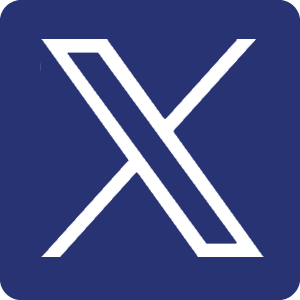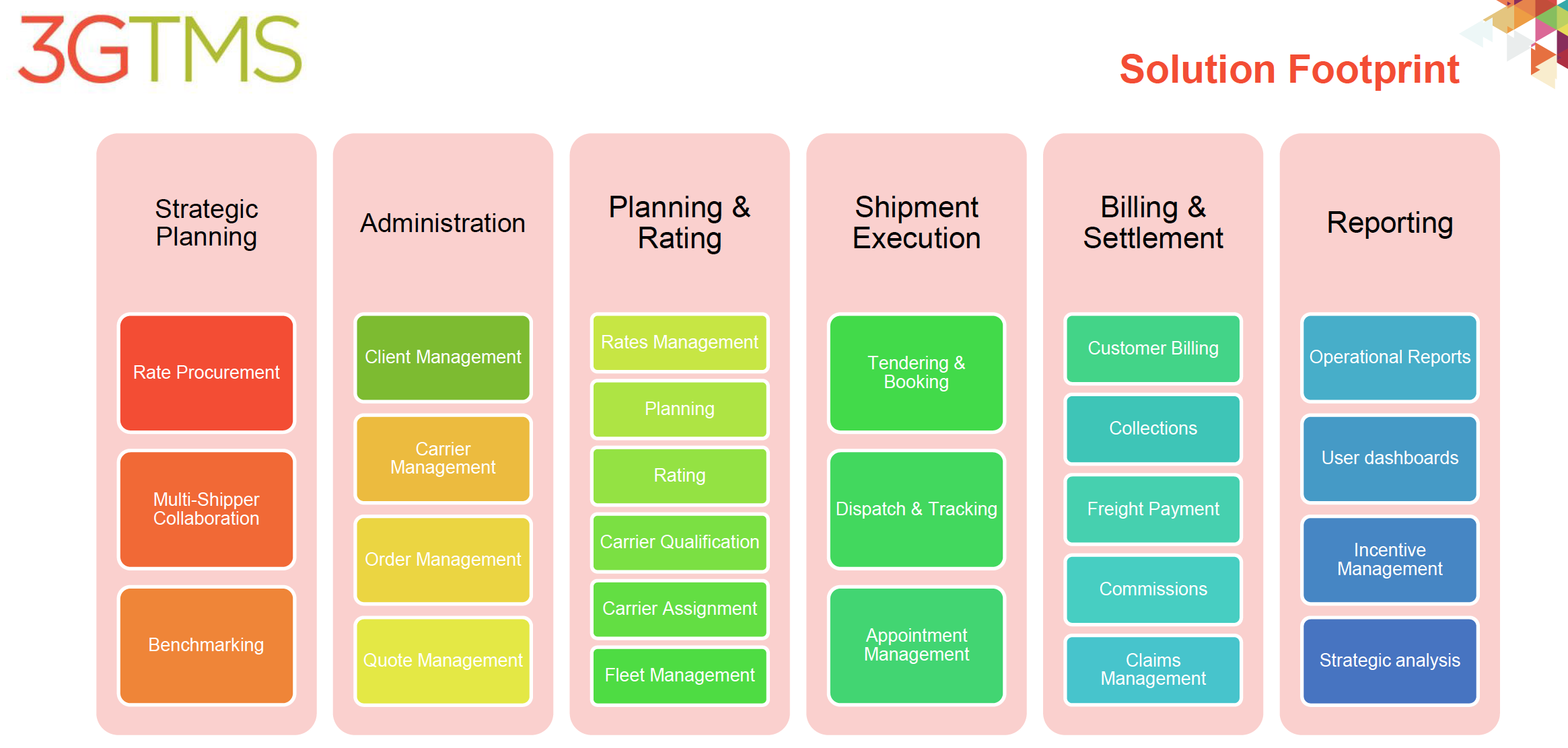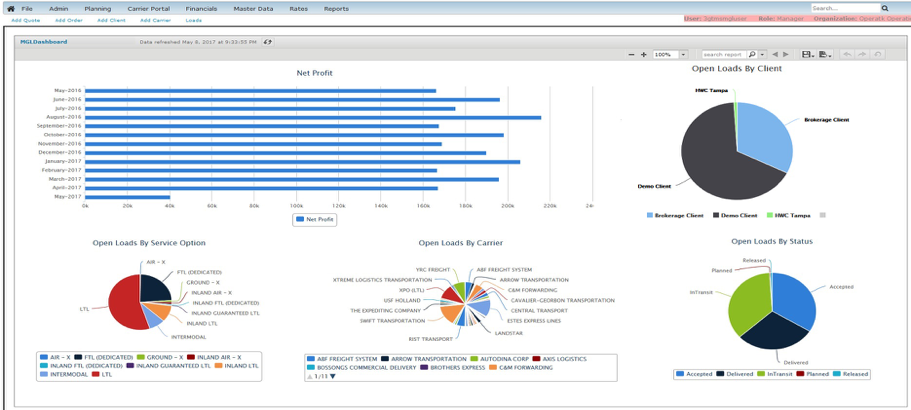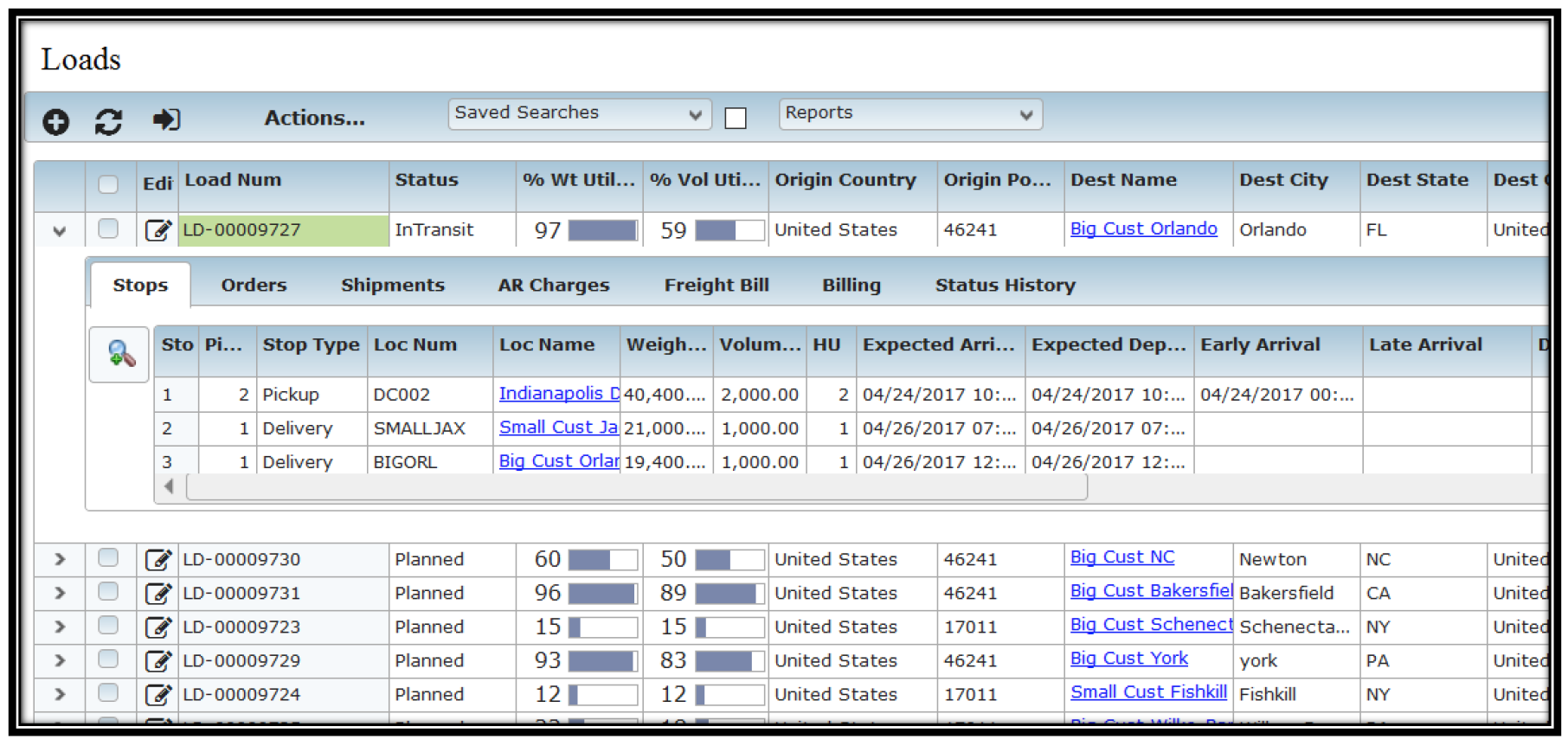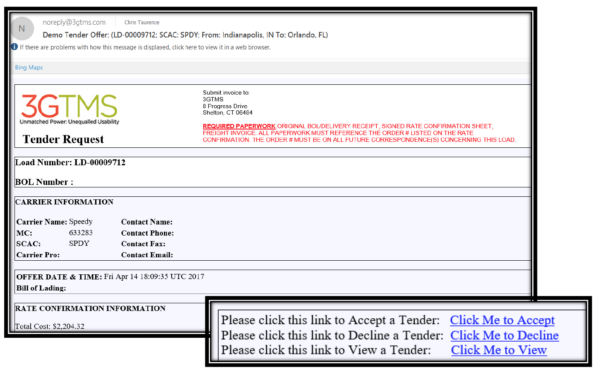3Gtms Transportation Planning and Execution
Shelton, CT USA Site Visit
June 7, 2017
By Armstrong & Associates, Inc.
Key Personnel
Mitch Weseley, CEO
Jerry Rau, Chief Operating Officer
Mark Smith, Chief Financial Officer
JP Wiggins, Vice President of Logistics and Co-Founder
David Sapienza, Vice President of Sales and Co-Founder
Chris Haarmeyer, Vice President of Development and Co-Founder
Chuck Fuerst, Vice President of Marketing
Dawn Salvucci-Favier, Vice President of Product Management
Chris Taurence, Vice President of Client Services and Co-Founder
Terry Wray, Vice President of Services
Mike Parmett, Vice President of Account Management
3Gtms Overview
Founded in 2013 by software veteran Mitch Weseley and a core team of long-time industry veterans, 3Gtms has developed a leading TMS for 3PLs, brokers, and shippers to manage the full transportation life cycle including order management, rating, routing, optimization, execution, tracking, and financial settlement. Its emphasis is on intra-continental transportation planning and execution, currently in North America and Europe. 3Gtms’ capabilities put the software in the company of peers like Oracle Transportation Management, MercuryGate, BluJay Solutions, and JDA.
Several years ago, Weseley noticed a trend in the marketplace: The chief TMS players were established in the late 1990s and early 2000s, yet no new companies were entering the top-tier TMS space. At the same time, TMS customers weren’t happy, he says, citing studies showing an implementation failure rate as high as 40 percent. Furthermore, Weseley saw a gap in product offerings. According to Weseley, existing in-house solutions, Tier 2 products, and even the lower Tier 1 products were not of the quality required for successful implementations. On the other hand, the top Tier 1 products were geared to a level of complexity that was only applicable to the largest shippers—this was overkill for the other 99%. Shippers and 3PLs needed a middle ground. In response, 3Gtms has invested over $20 million in creating a flexible, holistic, multi-modal TMS, built from the ground up. The company still heavily invests in research & development, and more than half the company’s 75 employees are on the R&D side of the business.
3Gtms has about 70 customers, and has seen significant growth in the past year. 2016 revenue grew 100 percent over the previous year. After landing several large and hotly contested contracts in the last six months, Weseley anticipates 100% revenue growth in 2017 with a 200% jump in sales growth. In the last quarter of 2016, 3Gtms was successful in six out of seven bids. In recent wins, customers cited superior domestic routing, rating, optimization, customer satisfaction, company culture, product flexibility, and team experience as key factors in their decisions.
3Gtms customers include YRC Worldwide, Crowley Logistics, Echo Global Logistics, Forward Air, Shippers Express Truck Lines, Bemis Manufacturing Company, Corsicana Bedding, ODW Logistics, Weiss-Röhlig, FloPath Automatic Logistics, JELD-WEN, NFI, Progistics Distribution, and Lactalis American Group.
Business Model Differentiators
Focus on Customer Retention
One metric stands out above all others to the 3Gtms board of directors: its customer attrition rate. According to Weseley, 3Gtms’ board has been very pleased with the company’s focus on customer satisfaction, as 3Gtms has achieved 100% customer retention. This customer-centric ethos is built into the company culture, filtering down from the CEO throughout the organization. The company credits its hands-on nature and differentiated software functionality as the main drivers of customer satisfaction. 3Gtms is also focused on ensuring a good customer fit during the sales phase. They’re trying to sell to dozens of customers, not millions, and the team focuses on making sure prospective engagements meet potential customers’ needs.
Intellectual Capital
3Gtms has built an experienced team with solid intellectual capital within the logistics industry. Every member of the 3Gtms senior leadership team has extensive tenure in the TMS industry, and hail from nearly every major player, including Oracle Transportation Management/G-Log, SAP, JDA (ITLS, i2, Manugistics, Red Prairie), BluJay Solutions (LeanLogistics), MercuryGate, and Manhattan Associates. CEO Mitch Weseley has a history of building successful software companies in the technology and logistics industries. Weseley was part of the founding G-Log team (later sold to Oracle and rebranded as Oracle Transportation Management), and his first company, Weseley Software Development Corp, was sold to McHugh Software International (later RedPrairie, now JDA).
The team built 3Gtms from the ground up using its knowledge of the industry and best practices, and to develop new and better ways to address challenging transportation problems. The team takes the long-view on capabilities, and leverages its industry knowledge to think of the implications of software changes 5—10 years down the road.
Software Differentiators
Still in the growth phase of the product life cycle, 3Gtms focuses on being agile and flexible. The software was conceptualized and built as a single-platform and system for brokerage, shippers, and 3PLs. The product incorporates order management, optimization, execution, finance, integration, and reporting, all in one system. Care went into the data framework, creating a hierarchy of orders, shipments, and loads. Features aren’t hardcoded, allowing flexibility in future enhancements. 3Gtms issues service releases every two weeks and major releases every eight weeks. It can be deployed as multi-client SaaS or private cloud.
Algorithm and Optimization
Optimization can often seem like it occurs in a “black box,” and it’s challenging to compare the optimization capabilities among different transportation management systems. 3Gtms’ strengths lie in simplifying this often-complex area for ease of use. Optimization was built in the execution layer, not as a separate tool. This allows dynamic re-optimization when conditions change—for example, if a carrier cancels a load, or customers change orders. Planners re-plan and re-optimize as changes occur.
The 3Gtms model is constraint-based, which means it presents executable load plan options. The company is using optimization as a differentiator, with claims that their newer models produce better real-world results and save more money in practice. Pool distribution and dynamic terminal selection is a highlighted strength.
Self-Configurability and Customization
Users can customize the portal, automate actions based on workflow, and create saved screens with a user’s preferred fields and menu options. 3Gtms assists with the initial set up, walking through the client’s business processes and assisting in translating these processes into a workflow within the software.
The software is also flexible in allowing different client customer access levels. Users at the 3PL and customers of the 3PL may access the system. The interface looks the same for all users, but customizable permissions vary based on the organization.
Integration and Implementation
Many customers have been particularly interested in 3Gtms’ integration and connectivity. 3Gtms considers integration simplification a key element in streamlining new customer implementations. While 3Gtms includes a robust XML API, years of experience has shown 3Gtms that most customers struggle with developing and maintaining integrations. To solve this challenge, 3Gtms provides a web-based integration tool, called 3G-Hub, which is used to connect to external systems and translate data formats. While most companies opt to have 3Gtms manage the integrations in 3G-Hub, clients can have full visibility to integration transactions and can choose to manage new integrations. 3Gtms can support API web services, flat file, EDI, templates for legacy FI, and ERP integrations. It has pre-established connections with most major LTL carriers and a library of templates for ERP, accounting, and EDI.
3Gtms’ 19-person implementation team averages 12 years of implementation experience. This team manages all implementations. Most of the team is focused on implementation, while four employees focus on integration work and tasks such as customer report development. Typically, two 3Gtms employees are on site during the implementation process for eight to 12 weeks, depending on resources available on the client side. Implementation team members will also train a “superuser” on the client side. Customer-facing support is through ZenDesk, and 3Gtms publishes technical documentation, articles, and integration and API resources.
Comprehensive Rating
Rating was one of the first pieces of the TMS that was built, therefore many of the earlier 3Gtms customers are heavily into freight audit, or are motor carriers using the rate engine as part of overall operations. Most functions in 3Gtms use real rates and real service performance metrics, but “planning” rates may also be used. The rating engine supports intra-continental modes including complex contracts and parcel, LTL, TL, intermodal, and spot market quotes. The engine has full support for 3PL “buy side” and “sell side” rating, including benchmark and gainsharing savings programs. Tools are available for costing, discounts, and rate analysis. For LTL rating and execution, customers may license tariffs and service standards from SMC3 or license this data from 3Gtms. Additionally, 3Gtms also maintains a neutral tariff rate base that can be used as an alternative to Czarlite. While most customers choose to calculate rates natively in 3Gtms, customers can also use carrier web API integration for rating including the options of going directly to the carriers or using third parties for this service.
3Gtms customers can also benefit from the rating engine without using the TMS because the rating engine can be accessed via a published web service API.
Key TMS Functionality
3Gtms uses a single platform for all functionality, including execution, optimization, settlement, and carrier management. The platform is a cloud-based, Excel-based user interface accessed via a web browser. 3PL planners use 3Gtms for all aspects of their workflow, from strategic planning through reporting. Carriers use the system to accept and decline loads and view documentation. Shippers can use 3Gtms for self-service shipping (the system can be customized with company branding).

